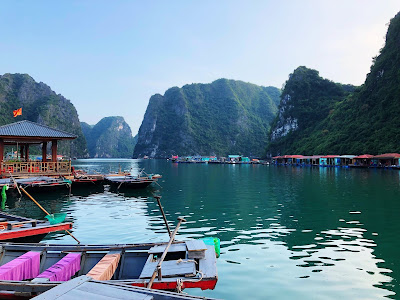A very early morning flight on the impressive airline VietJet,
we arrived early in Hai Phuong on Vietnam’s north-eastern coast to catch a
surprisingly quicker transfer (as we opted to not stop at the gift shop on the
way) than promised to Ha Long Bay.
Ha Long Bay – meaning “descending dragon” – is a UNESCO
Heritage site and in 2012 was named one of the 7 New Natural Wonders of the
World. The Bay features almost 2,000
limestone karsts and isles in all different shapes and sizes. The limestone in the Bay has experienced
500 million years of formation and the karsts have taken 20 million years under
the impact of the tropical wet climate. Local legend says that the gods sent
dragons to protect Vietnam from invaders, and these dragons spat pure jade,
which landed in the water to form the karst islands. The dragons found the area
so beautiful they decided to remain there, forever protecting Vietnam from
invaders.
 We boarded our boat, Bhaya Classic 3, along with 38 other
passengers, all of us eager for a unique way to celebrate Christmas. After an onboard safety briefing, we settled
into lunch to realize that we were certainly not alone in this idea - 600 other
tour boats also launched off into the Bay that day. And every day of the year. At the same time.
We boarded our boat, Bhaya Classic 3, along with 38 other
passengers, all of us eager for a unique way to celebrate Christmas. After an onboard safety briefing, we settled
into lunch to realize that we were certainly not alone in this idea - 600 other
tour boats also launched off into the Bay that day. And every day of the year. At the same time.Apparently the government controls when and where the boats will go, and in typical bureaucratic fashion the idea of staggering the departures seems to have not been considered. With overcrowded Hoi An and now Ha Long Bay, we were starting to wonder if Vietnam had become simply too discovered…
 Although we (and all of our shipmates) missed the boat’s 6am
Tai Chi session, we awoke early the next day to head out to some more remote
parts of the Bay. Too cold to swim, we
instead kayaked and had a fabulous morning checking out the limestone
formations, the small temples on deserted islands, and hidden beaches, while
also watching quietly a smaller fishing village community go about their
day. They checked the nets, repaired a
boat, sat with friends for lunch, all while children played boat games with
rocks in the water. After a day of
sailing, it felt we were seeing real life.
Although we (and all of our shipmates) missed the boat’s 6am
Tai Chi session, we awoke early the next day to head out to some more remote
parts of the Bay. Too cold to swim, we
instead kayaked and had a fabulous morning checking out the limestone
formations, the small temples on deserted islands, and hidden beaches, while
also watching quietly a smaller fishing village community go about their
day. They checked the nets, repaired a
boat, sat with friends for lunch, all while children played boat games with
rocks in the water. After a day of
sailing, it felt we were seeing real life. A short and too-touristy visit to a local pearl farm will
likely not stay long in our memories save for the cringe-worthy realization of
how they actually harvest pearls. They
first open the oyster shell, pull out its membrane and then reinsert a piece of
that membrane along with a mother of pearl ball into an oyster’s ovaries or
gonads before setting it back into the water to harvest for the next 3-8 years.
I think every man walked a little bit differently that afternoon after the tour.
A short and too-touristy visit to a local pearl farm will
likely not stay long in our memories save for the cringe-worthy realization of
how they actually harvest pearls. They
first open the oyster shell, pull out its membrane and then reinsert a piece of
that membrane along with a mother of pearl ball into an oyster’s ovaries or
gonads before setting it back into the water to harvest for the next 3-8 years.
I think every man walked a little bit differently that afternoon after the tour.
















No comments:
Post a Comment